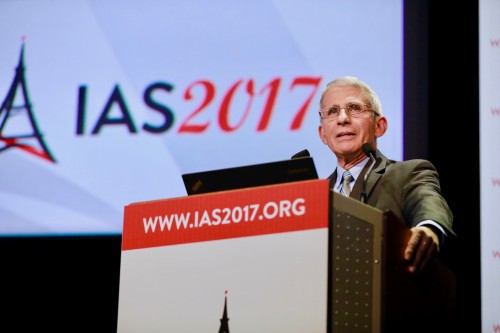Yet another study has found no transmissions of HIV within mixed-HIV-status couples when the partner living with the virus was on antiretroviral (ARV) treatment and had a fully suppressed viral load. Called Opposites Attract, the study of gay couples had nearly 600 cumulative years of follow-up data and about 12,000 reported acts of condomless intercourse on the part of the couples. These acts excluded any for which the HIV-negative partner was taking Truvada (tenofovir disoproxil fumarate/emtricitabine) as pre-exposure prophylaxis (PrEP).
Andrew Grulich, PhD, an HIV epidemiologist at the Kirby Institute at the University of New South Wales in Sydney and chief investigator of the study, presented findings at the 9th International AIDS Society Conference on HIV Science in Paris (IAS 2017).
“We think this is a really exciting result and adds to a body of research that HIV is not passed on in the context of undetectable viral load, even with high rates of sexually transmitted infections,” Grulich told conference goers.
Opposites Attract was the first study to show such findings in both high- and middle-income nations.

Andrew Grulich, PhD, an HIV epidemiologist at the Kirby Institute at UNSW Sydney in Australia at IAS 2017Benjamin Ryan
Preliminary data from Opposites Attract, which began recruiting participants in May 2012, were reported at the 2015 Conference on Retroviruses and Opportunistic Infections (CROI) in Seattle.
Opposites Attract did not restrict potential participants according to whether they had an undetectable viral load or used condoms. By the end of 2016, the study had enrolled 358 gay male couples in which only one partner was HIV positive, including 158 from Australia, 105 from Thailand and 96 from Brazil.
Researchers collected information about sexual behaviors from the HIV-negative partner at each study visit. These partners received HIV testing along with sexually transmitted infection (STI) testing upon entering the study and at all subsequent study visits. The HIV-positive partners received viral load and STI testing at each study visit.
The investigators defined an undetectable viral load as less than 200. For all new HIV infections in the initially HIV-negative partners, genetic testing was conducted to determine whether these men likely contracted the virus from their partner in the study.
A total of 343 couples made at least one follow-up visit, contributing 591 cumulative years of follow-up data. (Each year of data on a couple counted as one year of follow-up.) The men reported anal sex with any men beside their study partner at 57.4 percent of these visits.
Upon their entry into the study, 79.9 percent of the HIV-positive men were on ARVs and 77.9 percent had an undetectable viral load. A total of 75.2 percent of the men on HIV treatment maintained a fully suppressed virus throughout their participation in the study.
Overall, 14.3 percent and 11.7 percent of the HIV-positive and -negative men, respectively, were diagnosed with an STI during the study.
A total of 73.8 percent of the couples reported engaging in condomless sex during the study. These men provided 318 cumulative years of follow-up data on periods when they reported engaging in condomless intercourse within their study partnership, including a total of 16,889 reported such acts.
For about 5,000 of those sex acts, the HIV-negative partner was taking PrEP. (By the end of the study, 32.1 percent of the partners who did not have HIV had taken Truvada.) So for the researchers’ analysis of the association between an undetectable viral load and the risk of HIV transmission through condomless sex between men, they considered just the 12,000 condomless sex acts that were protected only by effective ARV treatment in the HIV-positive partner.
The final data set presented at IAS 2017 provided a somewhat smaller number of condomless intercourse acts within mixed-HIV-status gay couples compared with the PARTNER study, which in 2016 reported on 22,000 such acts and also saw no linked transmissions of the virus when the partner with the virus had an undetectable viral load. Thus, between Opposites Attract and PARTNER, participants reported about 35,000 condomless sex acts not otherwise covered by PrEP and no HIV transmissions between the partners.
Based on the amount of data collected in this one study, the investigators were able to estimate that the annual risk of HIV transmission among gay couples in which only one partner has the virus and he has an undetectable viral load is between zero and 1.56 percent. However, when looking at the results of Opposites Attract along with those of two similar studies, HPTN 052 as well as PARTNER, researchers are increasingly coalescing around the notion that HIV transmission is likely impossible when the virus is fully suppressed thanks to ARV treatment.
Three of the initially HIV-negative men in Opposites Attract did contract the virus during the study, but the researchers determined that none of the strains were genetically linked to their partner with whom they participated in the study.
“This is life-changing news for couples of differing HIV status,” Grulich said of the Opposites Attract findings. “But it is important that the HIV-positive partner is under regular medical care and does not miss any of their antiretroviral medication in order to ensure they maintain an undetectable viral load. Our data add to previous studies that show that there has never been a recorded case of HIV transmission from an HIV-positive person to their HIV-negative sexual partner when the HIV-positive partner had undetectable viral load.”
The authors of the PARTNER study were able to conclude, based on the size of their data set, that there is a “very low” risk of HIV transmission within mixed-HIV-status gay male couples in which the HIV-positive member has a fully suppressed viral load. The study had more data on heterosexual couples than on gay couples, allowing the investigators to determine that the comparable risk for this population is “extremely low.” An extension of PARTNER including only gay couples is currently running so that the researchers can gather more data to refine their risk estimate for this demographic.
Another study, HPTN 052, included only heterosexual mixed-HIV-status couples and in 2016 reported in its final results that there were also no linked transmissions of the virus within the couples. The HIV-positive and -negative participants in this study were followed for a cumulative 10,000 and 8,500 years, respectively, although there were no data on the number of condomless sex acts between them.
“We think these findings really strongly support the hypothesis that condomless sex with an undetectable viral load is a form of safe sex," Grulich said.
Grulich and his team stress, however, that when an individual starts HIV treatment, it may take up to six months for the viral load to reach undetectable. During this time, there may be a significant risk of transmission.
Given all this data, Anthony S. Fauci, MD, director of the National Institute of Allergy and Infectious Diseases (NIAID), characterized the risk of HIV transmission through condomless sex among men or women with an undetectable viral load as “vanishingly small” or “even negligible.”

Anthony S. Fauci, MD, director of the National Institute of Allergy and Infectious Diseases (NIAID), speaking at IAS 2017Benjamin Ryan
Editor’s note: Due to an editing error, the initial headline of this article incorrectly stated that this study was the second to find no linked transmissions in the context of an undetectable viral load; there have been several such studies.
Benjamin Ryan is POZ’s editor at large, responsible for HIV science reporting. His work has also appeared in The New York Times, New York, The Nation, The Atlantic and The Marshall Project. Follow him on Facebook, Twitter and on his website, benryan.net.







4 Comments
4 Comments